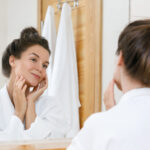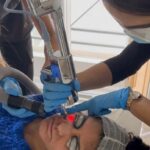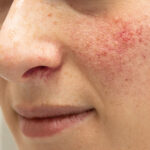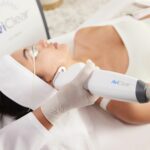
When it comes to looking after your skin, prevention is always better than cure. However, with the best will in the world, we are not perfect and sometimes it is easy to get caught out despite being careful. Sunny and hot weather is glorious, but sunshine brings with it the threat of sunburn and it is important to have the necessary tools at hand to know how best to manage this.
Sunburn is an acute inflammatory reaction which follows over-exposure to ultraviolet radiation. It causes direct damage to DNA, which results in inflammation and death of skin cells. Repeated sunburn can increase your lifetime risk of developing skin cancer in later life and the risk should be taken seriously. Signs and symptoms usually develop 2-6 hours after sun exposure and peak at about 12-24 hours. Your skin may become hot, red and tender, and blisters can form. In severe cases, it is possible to develop dehydration, imbalances of the important salts in your blood, and skin infection. In rare cases, it has the potential to be fatal.
There are a number of steps you can take if you develop sunburn to relieve discomfort and aid the healing process of the skin:
- Act quickly and get out of the sun; cover up the affected areas and stay in the shade until your sunburn has healed. Wear loose cotton clothing that allows your skin to “breathe” over the sunburnt areas.
- Take over-the-counter pain relief if needed. This can help reduce both pain and inflammation caused by sunburn. Non-steroidal anti-inflammatory drugs (NSAIDs) such as ibuprofen are ideal (provided you are safe to take this type of drug) and should be continued for a period of at least 48 hours. Paracetamol can help with pain but will have little effect on inflammation.
- Cool the skin. Apply a cool compress such as a towel dampened with cool water for 15 minutes, or take a cool bath or shower. Aim to keep the temperature just below lukewarm in all three cases. Make sure the shower has a gentle flow of water rather than being on full power. If blisters are starting to develop, then a bath is preferable. Do not rub your skin with a towel, but gently pat it dry when you get out.
- Moisturise after your bath or shower and use a fragrance-free cream or lotion to soothe the skin. Repeated applications of this are necessary to reduce the appearance of peeling and may need to be continued for some weeks. Aloe vera, or soy-containing gels or lotions, can be helpful; aloe vera not only has a cooling effect on the skin but also acts as an anti-inflammatory agent. Be wary of creams containing ingredients such as petrolatum, benzocaine or lidocaine which may trap heat in the skin or cause local irritation.
- Stay hydrated as sunburn can encourage fluid loss through the skin. Drink plenty of water to prevent dehydration and ideally avoid alcohol which may make dehydration worse due to its diuretic effect.
- Use a mild steroid cream (e.g. 0.5-1% hydrocortisone) for 48 hours which can help decrease pain and swelling caused by sunburn and speed up the healing process. This is best avoided in children.
- Leave blisters alone; try not to pop them as this can lead to infection and scarring. They will usually settle by themselves in a few days.
Severe cases of sunburn require emergency medical treatment. If you develop blisters that affect up to 20% of your body surface area or other symptoms such as fever, nausea, chills, severe pain, headache, fainting or dizziness it is vital you seek medical attention. Severe sunburn can be associated with heat exhaustion or heat stroke which are life-threatening.
In an ideal world, none of these measures should be needed and preventing sunburn should be the focus. Not only does it cause short-term discomfort, but over the long-term it will increase your risk of skin cancer and premature skin ageing. Make sure you are using a broad-spectrum sunscreen with both UVA and UVB protection with an SPF 30-50. Remember this is only part of healthy sun-seeking behaviour and wearing a hat, sunglasses and protective clothing alongside seeking the shade especially in the hottest part of the day are vital. That said, keep this blog bookmarked in case you get caught out over the summer months!





